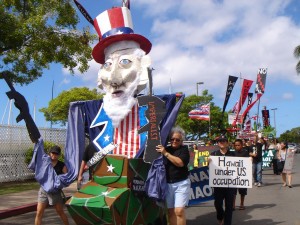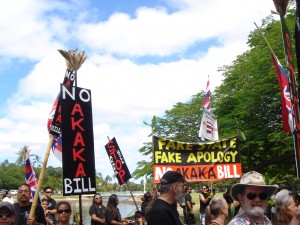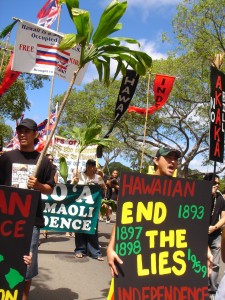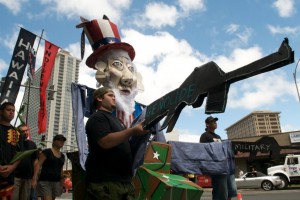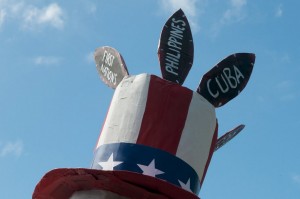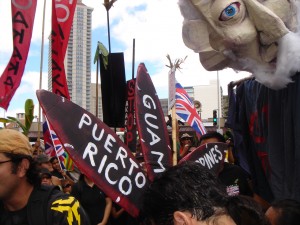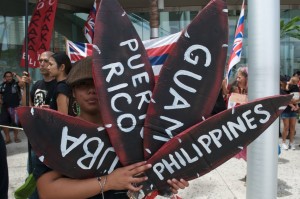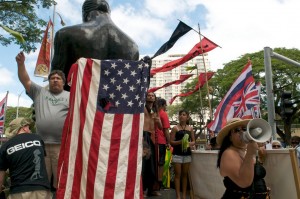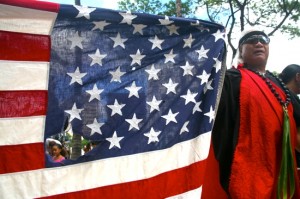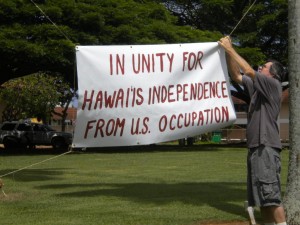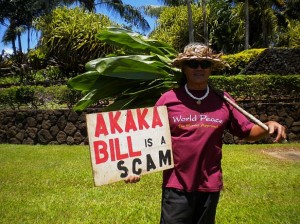Citizens denied access to meeting protest outside Pohakuloa Training Area
http://bigislandweekly.com/articles/2010/03/03/read/news/news03.txt
Citizens denied access to meeting protest outside PTA
By Heather Nicholson
Wednesday, March 3, 2010 11:38 AM HST
About 30 people concerned with depleted uranium (DU) radiation on Pohakuloa Training Area picketed outside the Saddle Road military base Feb. 24. At the same time, the group received word that their petition to challenge the Army’s license to possess DU was denied.
Jim Albertini, group leader and founder of the non-violent education and action group, Malu Aina, expressed disappointment at the decision handed down from the Nuclear Regulatory Commission (NRC), who said the petition “lacked standing.”
“It means citizens have nothing to say about this issue,” said Albertini, who went in front of the NRC with three other Hawaii residents in January calling the Army’s assessment of DU hazards inadequate.
Though Albertini and his group were not invited to the U.S. Army’s annual Community Leaders Day, various decision makers were seen in attendance, including Mayor Billy Kenoi. The attendees heard progress updates on everything from Saddle Road construction to depleted uranium.
U.S. Army spokesman Mike Egami said the DU discussion was a review of topics already on the radar, including the Army’s application to the NRC to possess and manage residual quantities of DU at various bases, including Pohakuloa Training Area (PTA).
Repeated attempts to contact Kenoi’s office for information about the meeting went unanswered. When the Army was asked to provide Big Island Weekly with a list of the attendees, we were told the group consisted of “politicos or representatives from various offices from the Mayor’s office, County Council, Congressional offices, business leaders, UH Hilo, school principals, DLNR, hunters, and members of the PTA Cultural Advisory Committee.”
“The community leaders were invited to provide opportunities for each to take back information to their respective organization and disseminate information, as well as receive comments to provide back to the military,” said Egami.
The majority of protesters opposed to the fact that the public was not invited to the meeting and stood across from the entrance of PTA holding signs that read “Where’s the transparency” and “Radiation cover up.” The group tried several times to get inside the base and was denied a list of invited attendees.
“We want this meeting that they are having about our neighborhood to be open,” said Hilo resident Stephen Paulmier. “It’s mainly about transparency in government.”
Ret. U.S. Army Col. Ann Wright stood on the side of Albertini’s picket line, concerned that the politicians invited to the meeting could not be trusted to ask the Army hard questions.
“This meeting undercuts the citizen’s right to know. It’s outrageous that no one can go in since there’s been so much public outcry,” she said.
WHAT IS DEPLETED URANIUM?
Depleted uranium is a waste obtained from producing fuel for nuclear reactors and atomic bombs. DU is extremely dense and heavy, so much so that projectiles with a DU head can penetrate the armored steel of military vehicles and buildings. It is also a spontaneous pyrophoric material that can generate so much heat that when it reaches its target it explodes.
The American military has been using DU to coat artillery, tanks and aircraft for years, and the DU found on Hawaii military bases came from The Davy Crockett, a series of recoilless guns used in 1960s training missions.
When exposed to very high temperatures, DU can go airborne. According to the World Health Organization, DU emits about 60 percent of the radiation as natural uranium. When inhaled, DU particles make their way into the blood stream and can cause health problems, especially to the lungs.
When DU was discovered at Hawaii military bases in 2006, the Army received much backlash after years of denying that any uranium weapons were ever used on island. After military testing of the remaining DU at PTA and Oahu’s Schofield Barracks, the Army contends that the radiation is too low to be a health concern.
Pahoa resident and retired Army pilot Albert Tell agrees.
“There’s more radiation in my house then there is out here,” Tell said.
Tell and about 10 other military supporters comprised mainly of ex-military personnel picketed outside PTA on Feb. 24 also. Brandishing several American flags and dressed in military fatigues, the group said they were there to support the troops, PTA and counteract any misinformation Albertini and his supporters handed out.
“I don’t know anyone who’s died from DU,” said a picketer who refused to give his name. “We have some dying from cancer but they’ve lived other places to.”
IS DU BAD FOR YOU?
It’s true the long-term effects of DU radiation are largely unknown, and while some contend DU is the cause of Gulf War Syndrome there are no tests or reports to support it. Since DU goes airborne under extreme heat, some citizens are concerned that the live-fire and bombing training missions still conducted on PTA are aerosolizing DU and not only putting down-wind communities at risk, but active PTA soldiers as well.
Albertini said he won’t be satisfied until the Army allows independent scientists to conduct their own DU tests on PTA. He also wants all live-fire and bombing sessions on PTA halted until an independent DU test can be conducted.
“We have to know the extent of the health risks,” he said.
Hawaii County Council passed a resolution calling for the halt of live-fire and bombing that may spread airborne DU, however, the Army continues to do so. They said it is highly unlikely that DU will move off PTA and into the community due to military live-fire training.
“The Army has completed most of the DU investigation, but is continuing to monitor the water and air qualities at Schofield Barracks and PTA,” Egami said.
The Army is also awaiting a decision from NRC regarding their license to possess DU.


